Valencia will host the second leg of the UEFA Champions League rounds of 16 against Atalanta on Tuesday, 10 March 2020.
It will be interesting to see whether or not Albert Celades’ side can pull off a comeback after they succumbed to a heavy 4-1 defeat at Stadio Giuseppe Meazza in their last meeting. Meanwhile, Gian Piero Gasperini and his men will face the game with more vigour and a bit of relaxed feeling as they already secured a three-goal lead and pretty much have one foot set in the quarter-finals.
In this tactical analysis, we’ll break down both team’s tactics and give you a preview of what is to be expected tactically and what should both teams do to exploit each other’s weaknesses.
What Valencia should do to defeat Atalanta
Valencia tend to play from the back but they’re actually quite direct. Last time out against Atalanta, Valencia were denied the access to play from the back and were often forced to play long, allowing Atalanta the chance to recover the ball via winning the second ball.
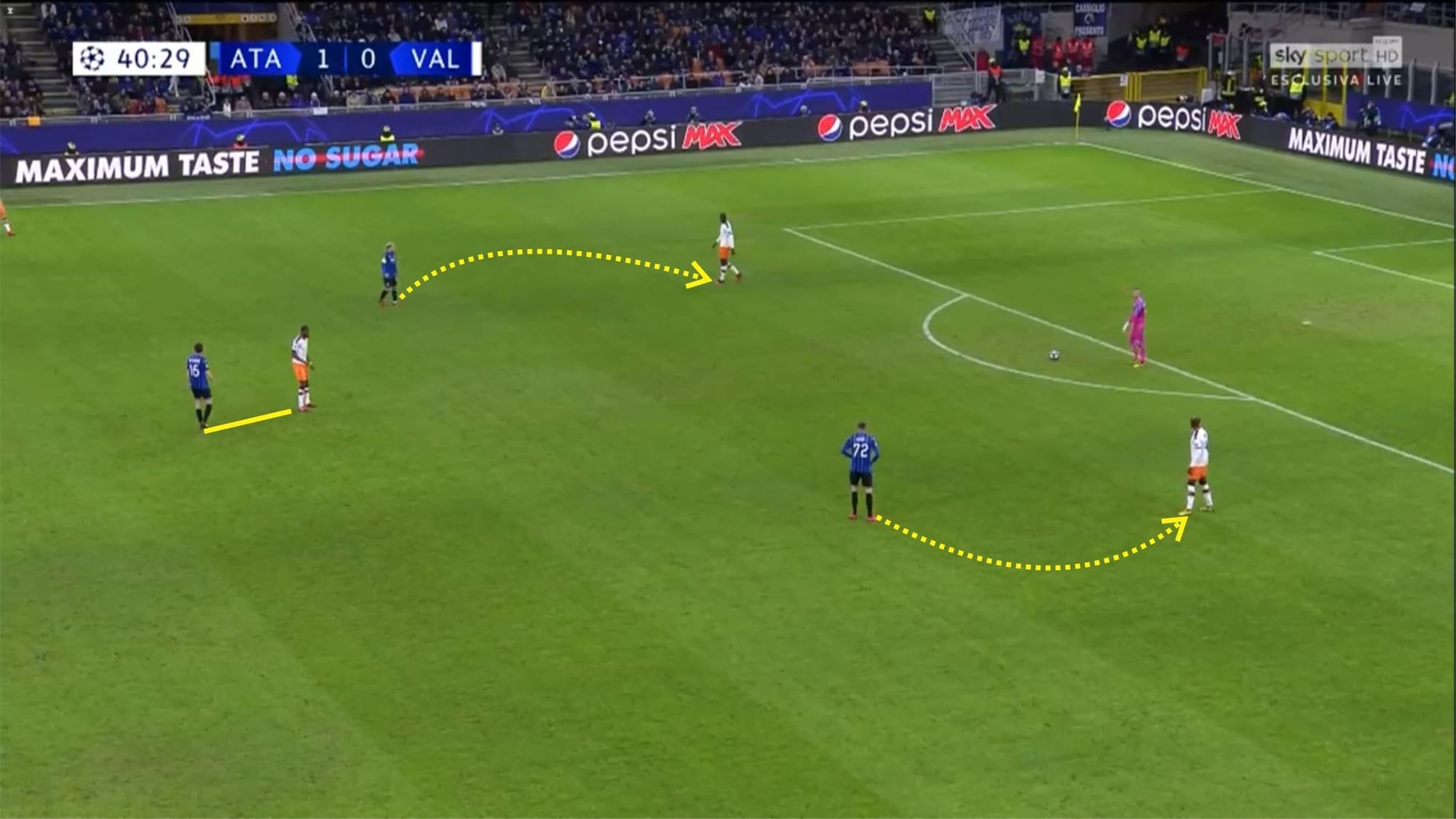
As you can see in the image above, Gasperini’s side adopted a man-oriented approach in defending. If the ball was given to either centre-back, the nearest man would close him down by coming from his side, thus effectively putting the originally unmarked full-back in his cover shadow and rendering him inaccessible. A clearer image of what’s happening can be seen below.
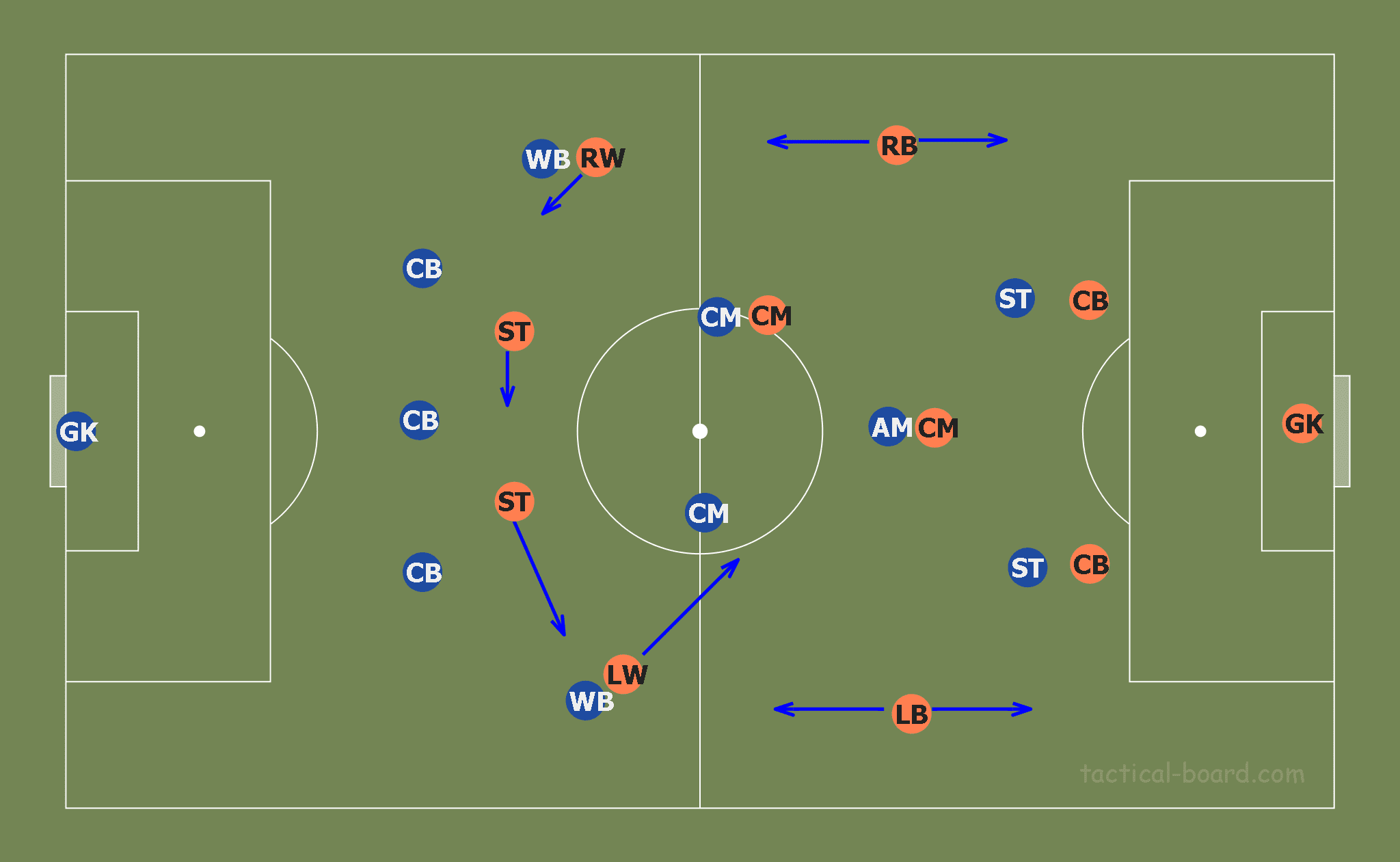
Above is a commonly seen shape of Valencia in the build-up when playing against Atalanta. You can also see Atalanta’s defensive shape and approach here.
The left-winger (Carlos Soler) tended to drop and occupy the central space in the middle third. One of the two strikers were allowed much freedom in his movements and would usually move wide to fill the space left by the left-winger. Meanwhile, the other striker stayed centrally. In their last meeting against Atalanta, both wingers tended to sit in the half-space, allowing the full-back to exploit the space out wide.
Meanwhile, instead of playing with a double pivot, Valencia played with a lone pivot in that game with Geoffrey Kondogbia and Dani Parejo frequently took turns dropping to receive and sitting higher. However, with Atalanta tending to crowd the middle as well as man-marking the central players, central progression looked to be the more difficult route.
The full-backs tended to sit quite high and didn’t drop down a lot in that game. If either or both full-backs come down, it may be easier for Valencia to escape Atalanta’s frontline pressing and man-oriented marking as Atalanta’s wing-backs usually would already be occupied by Valencia’s wingers and be forced to sit deeper. Valencia should then be able to progress the ball through the flanks.
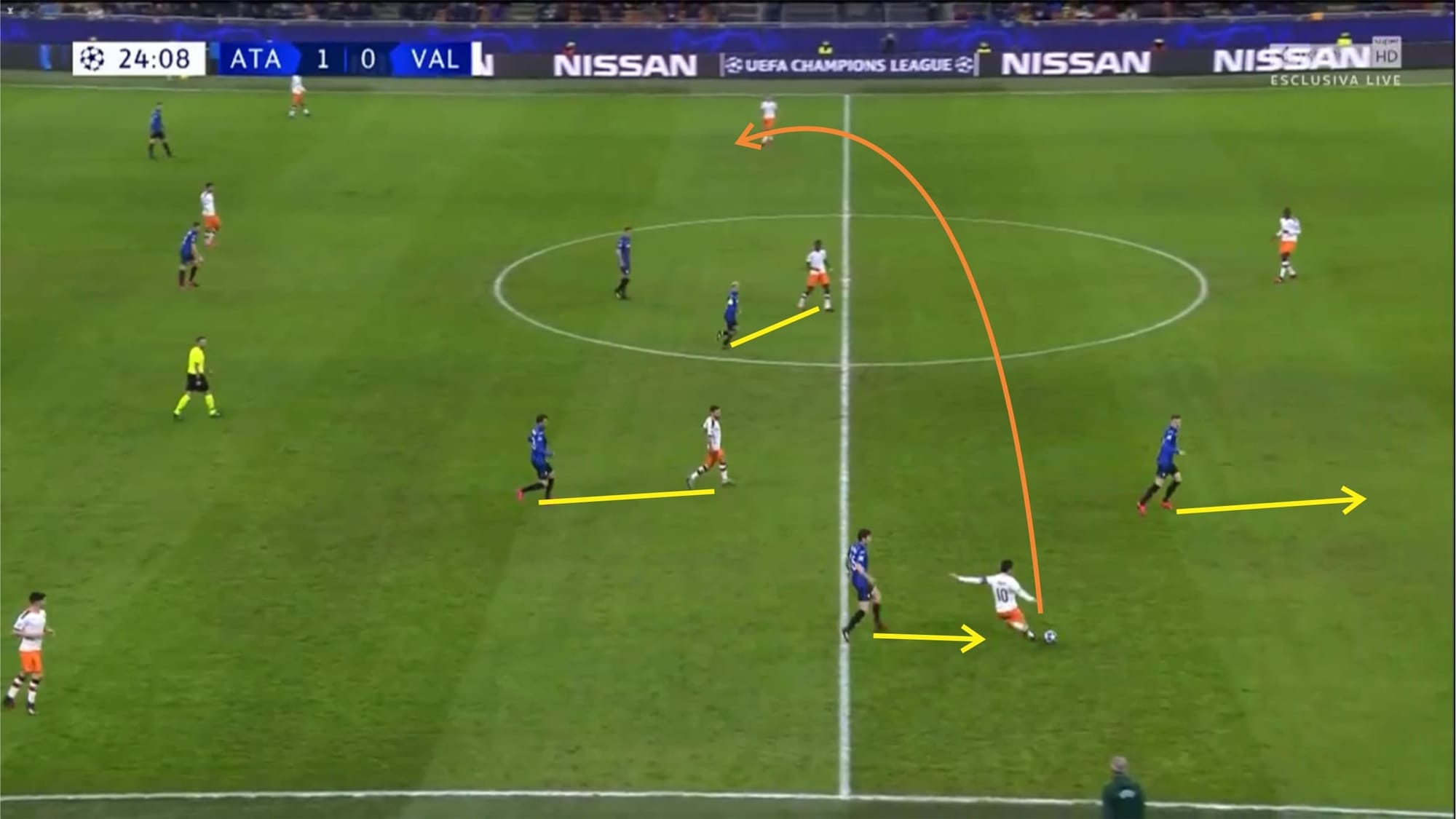
Although progression via flanks should be more accessible, Atalanta will quickly overload one side of the pitch if the ball is moved there. It’s important for Valencia to switch play often if nearby options are all marked and the ball-carrier is isolated.
As you can see in the picture above, Valencia managed to stretch the defence and then attract Atalanta’s pressure so they would then overload that side of the pitch. Once that was done, the ball was then moved into an underloaded area.
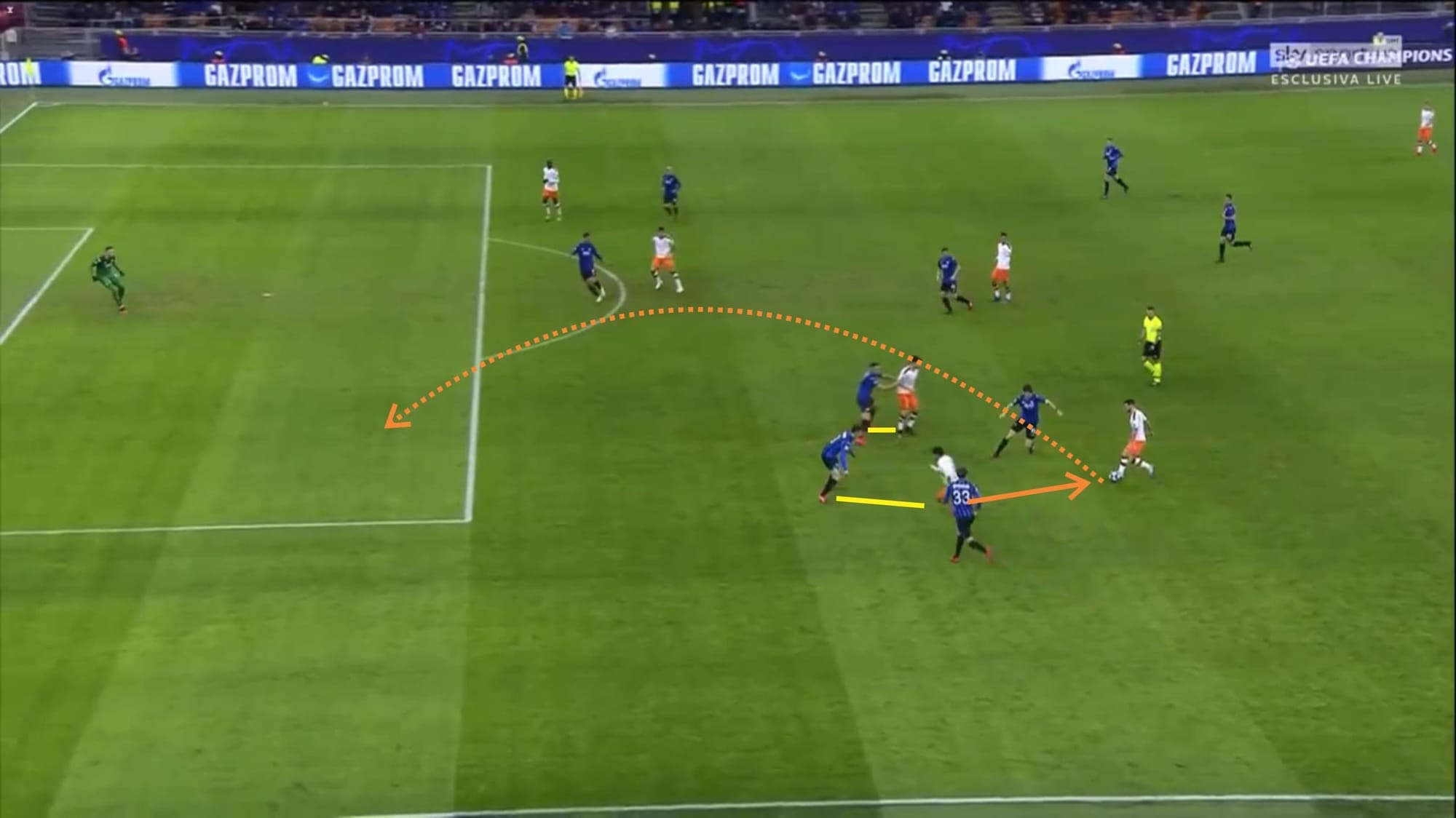
As mentioned before in this tactical analysis, Atalanta tend to mark their opposition man for man all over the pitch. That means Valencia can potentially disorganise their defence by using fluid positional rotations to drag marker out of position or to dismark.
In the picture above, Gonçalo Guedes moved a bit wider and dropped a little bit, dragging his marker (Atalanta’s right-sided centre-back) with him, creating space behind the defence. You can also see in the image above that Soler, who sat in the half-space, left his original marker (Atalanta’s right-sided central midfielder) and engaged the middle centre-back, also dragging him out and creating space in behind. José Gayà spotted the space in behind the defenders as well as Guedes’ acceleration and he chipped the ball onto the path of the quick-footed Portuguese forward.
Apparently, Atalanta’s strongest weapon in attack can be used against themselves. Fluid positional rotations as well as switching play often to exploit underloaded areas were clearly key in Valencia’s attack the last time out and they really should do the same in the next match.
However, Valencia’s main problem against Atalanta the last time out was not that they were unable to break Atalanta’s defence, but they were ineffective in front of goal. Valencia registered 16 attempts on goal in that match, but only five (31.25%) of them were on target. Those attempts resulted in a 2.84 xG, however, they only managed to score one goal.
Their high, man-oriented pressing, as well as aggressive counterpressing, seemed to work well in that match (especially in the second half of that game) as Atalanta were quite prone to losing the ball inside their own half. Aside from potentially being able to win the ball, Valencia could also delay Atalanta’s counter-attacks if they managed to apply aggressive pressure as well as block the access to the counter-attacking targets upfront.
Meanwhile, Atalanta produced only 11 shots with five (45.45%) of them being on target – fewer in quantity but more accurate. Their attempts resulted in a 1.64 xG which is quite low considering they managed to score four goals in that match. Atalanta were not afraid to take shots from long range and surely, if given space, they’ll try to have a crack from outside the box again in the next match. Valencia should allow no space and time for Atalanta’s players if they managed to get the ball in the final third. However, they should still be wary of Atalanta’s drag-out-and-exploit-space tactics.
How Atalanta can seal the deal
Generally, Atalanta are looking to maintain possession. They’ll move the ball around using quick short pass combinations as they aim to create openings by testing the opposing team’s defensive discipline and forcing the block to move quickly from one side to the other. Once they find that gap though, expect them to break forward very quickly.
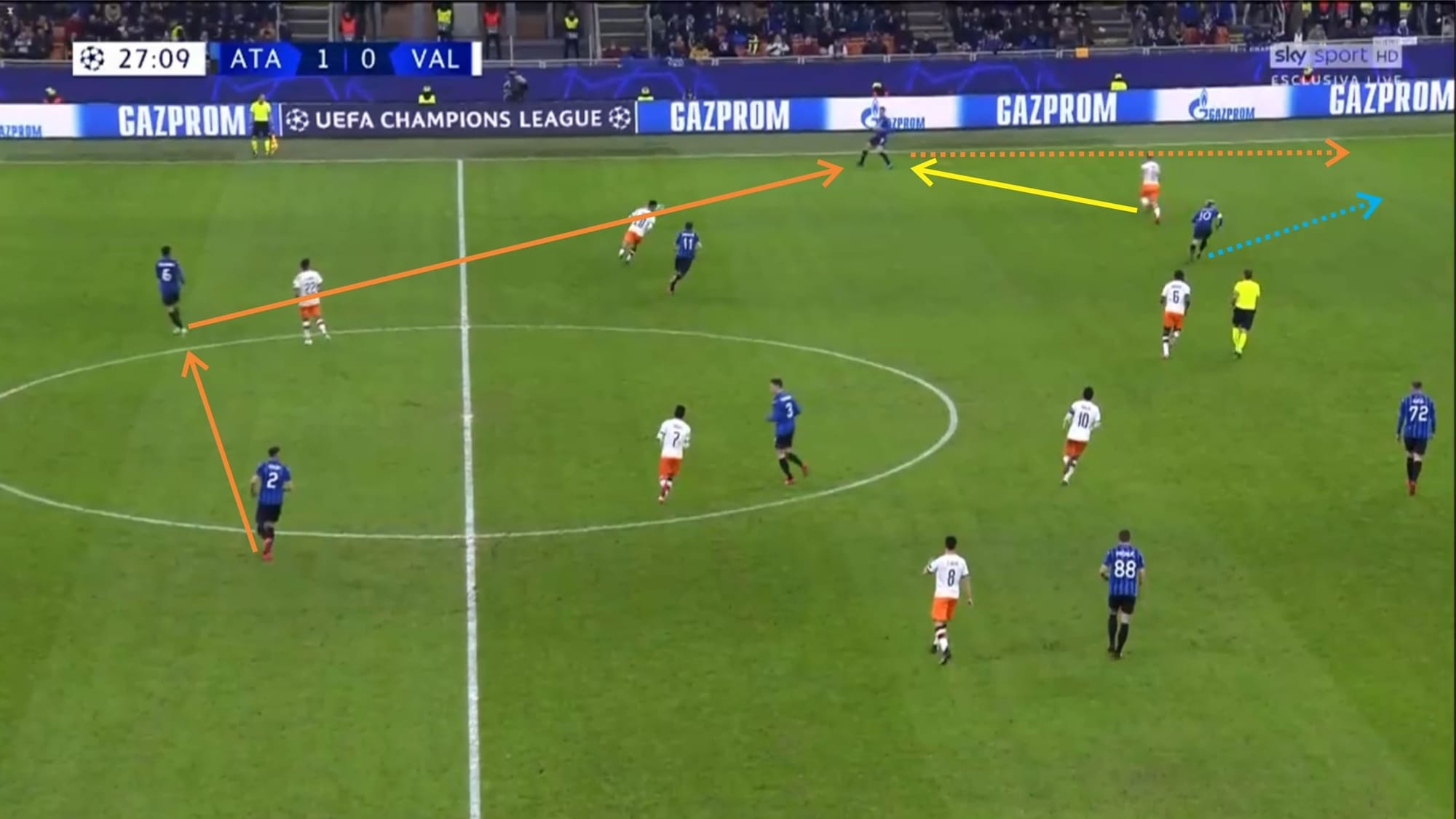
Gasperini’s side switch play often, either via a long pass or a series of quick short-medium passes. This helps them disorganise the opposing team’s defence and break through deep blocks.
In the image above, Alejandro “Papu” Gómez initially occupied Daniel Wass while Ferran Torres sat narrower and marked Remo Freuler to prevent central progression. This meant that left wing-back Robin Gosens was left free on the left flank. Upon seeing the ball being played to Gosens, Wass immediately closed him down – however, leaving Gómez free in the process. Lucky for Valencia, Wass managed to read the pass towards Gómez and intercepted it before it could turn into a danger.
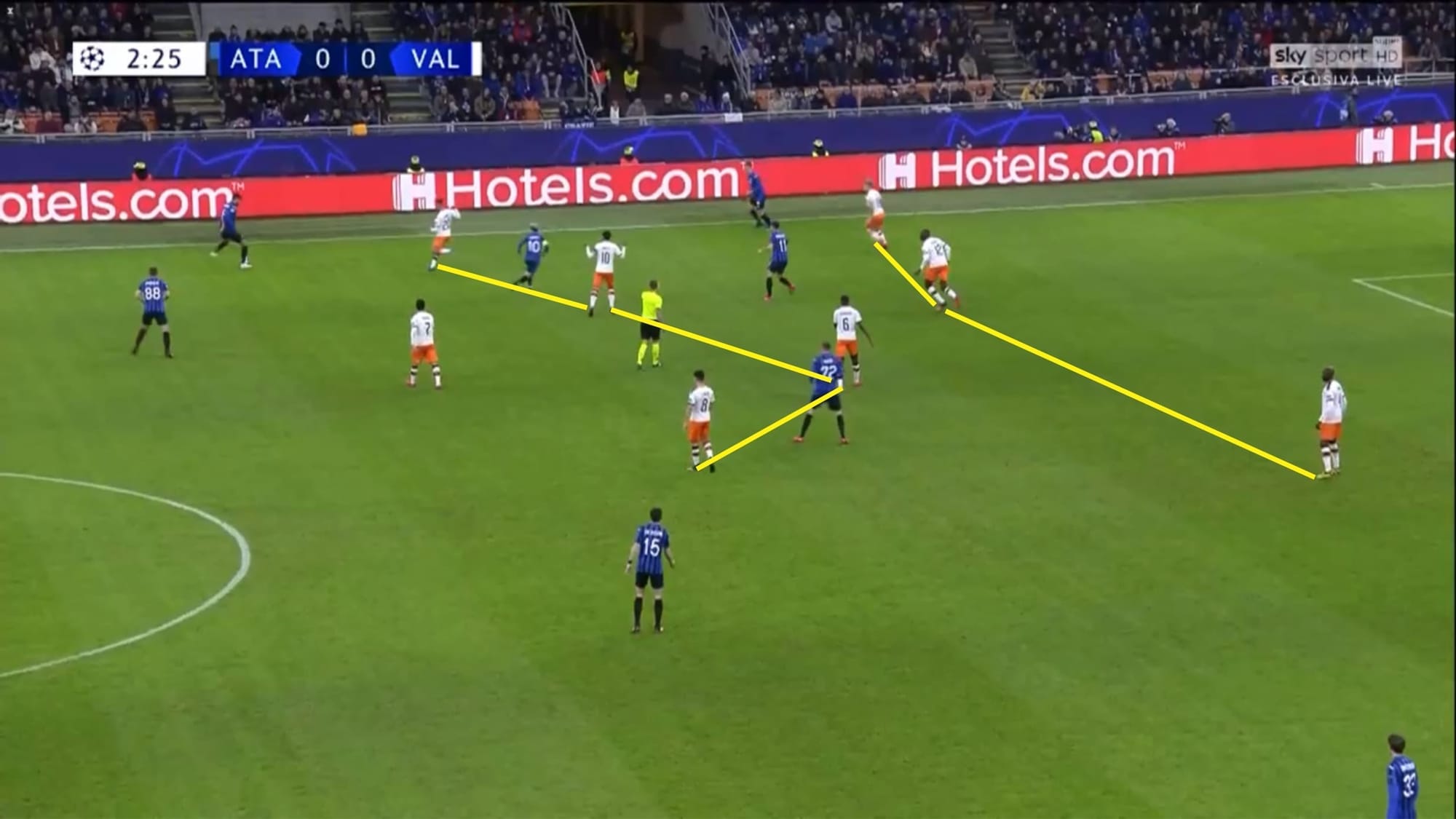
Valencia tend to defend with two lines of four and two players upfront as the first line of pressure. When the ball is deep inside their own half, the shape shifts into a 4-4-1-1 where one striker stays advanced as the main counter-attacking target and doesn’t get involved a lot in defence while the other one maintains position in around the middle third to be the “link” between the defence and attack in transition.
As you can see, Valencia’s defence were very compact and narrow. Mainly, their focus was to crowd the middle and prevent central progression. However, if the ball was moved wide, they’ll try to commit players into that area to outnumber or equal the number of their opposition. However, there are some weaknesses in this approach.
Valencia are using a mix of man and space coverage approach in defence. The ball-near players are usually man-oriented while the ball-far are either passing lane-oriented or covering space. With Atalanta’s strikers tending to sit in the half-space or roam wide to create wide overloads rather than stay centrally, the centre-back (that is marking the striker) would naturally follow the striker’s movements which could create a gap and split the two centre-backs up. This can be, should be, and certainly will be exploited by Atalanta in the next match if a similar situation occurs.
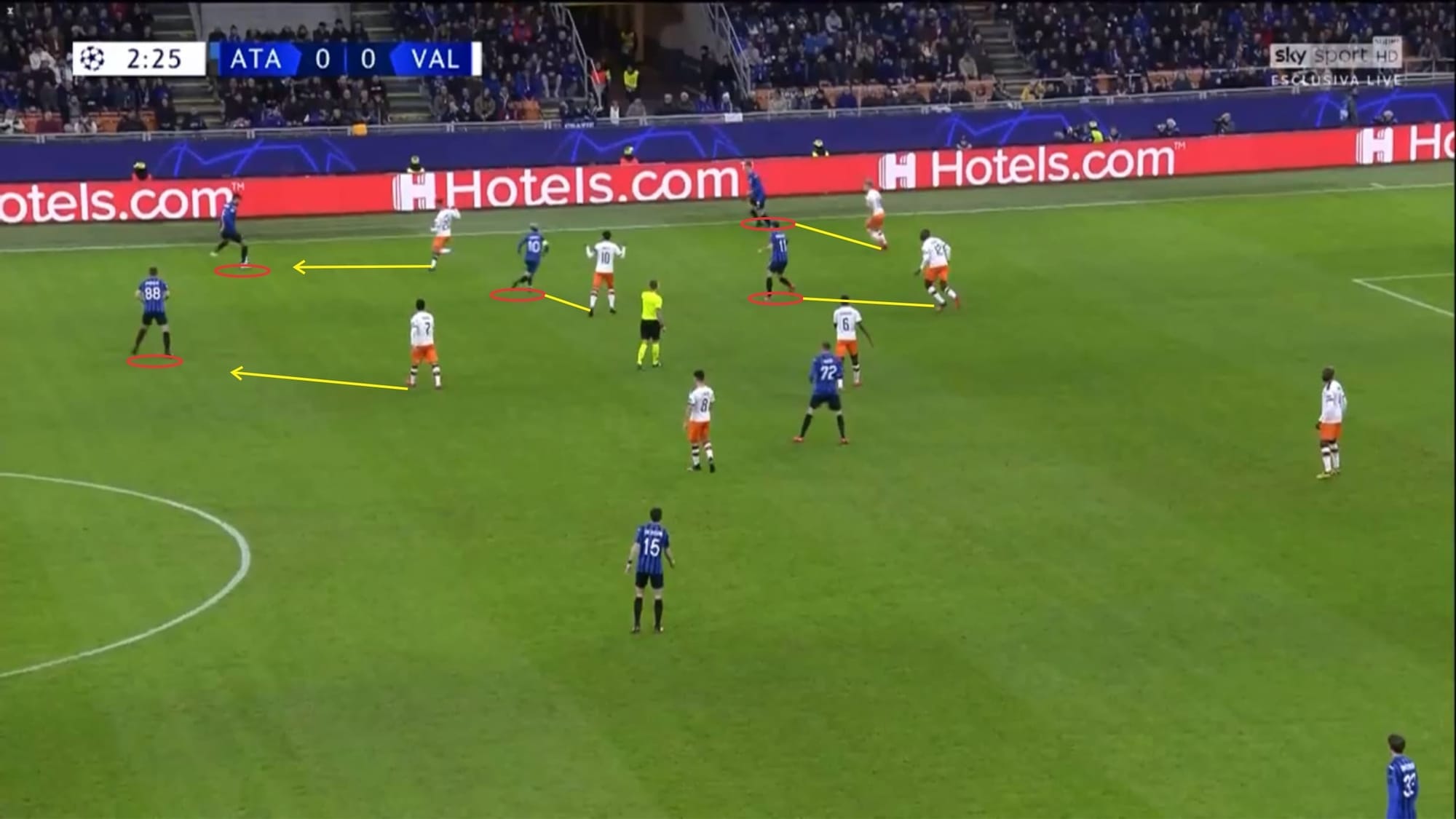
As you can see in the image above, Atalanta has the tendency to combine in the half-spaces and flanks and create chances from there. That’s why they’d mainly look to create overloads on the flanks by having the strikers roam wide rather than centrally and having the centre-backs advance forward as well.
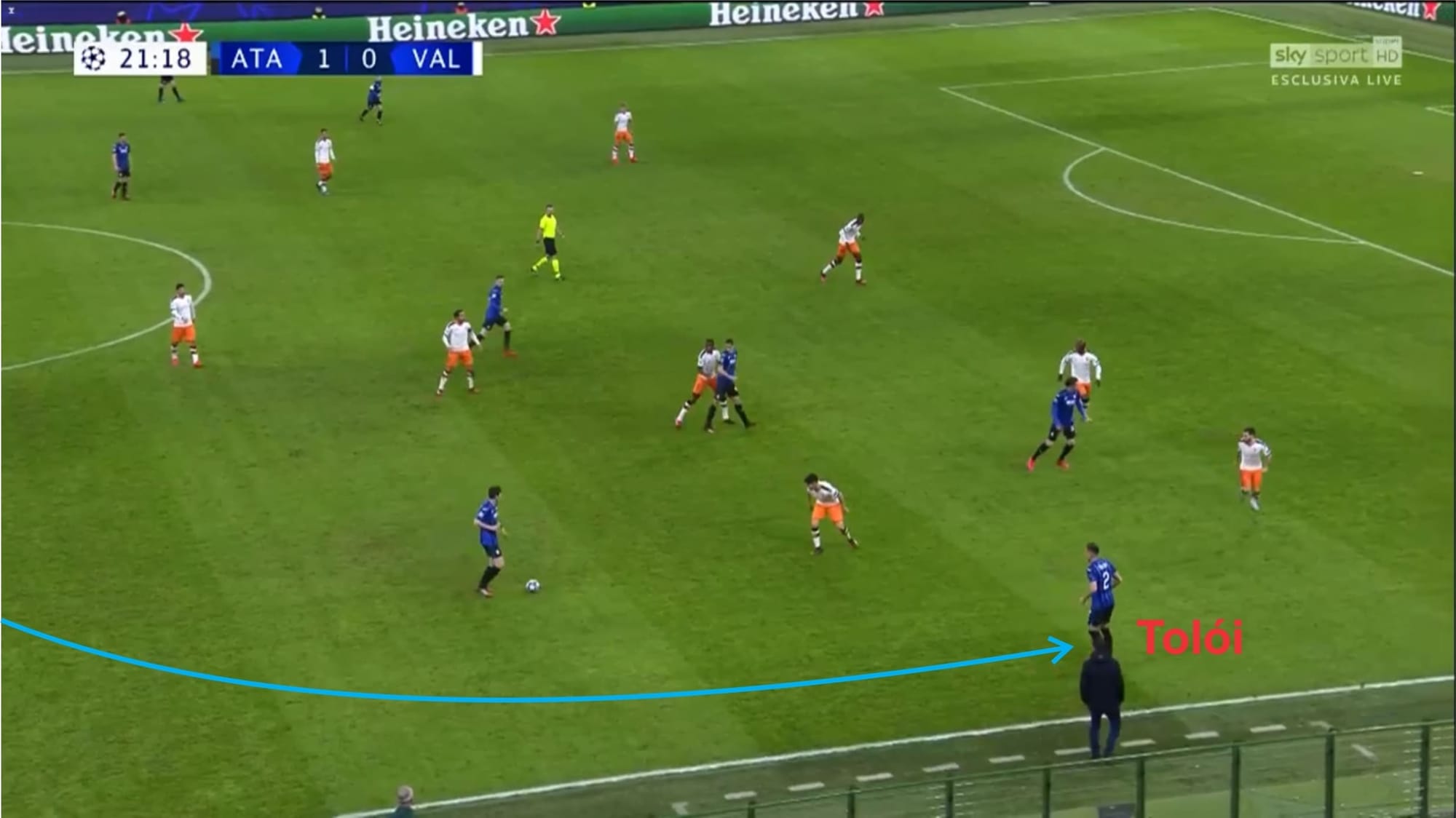
If Valencia managed to block all the access and prevent further progression, Atalanta will then look to move the ball to the other side, exploiting the underloaded area. An example of that situation can be seen in the picture below.
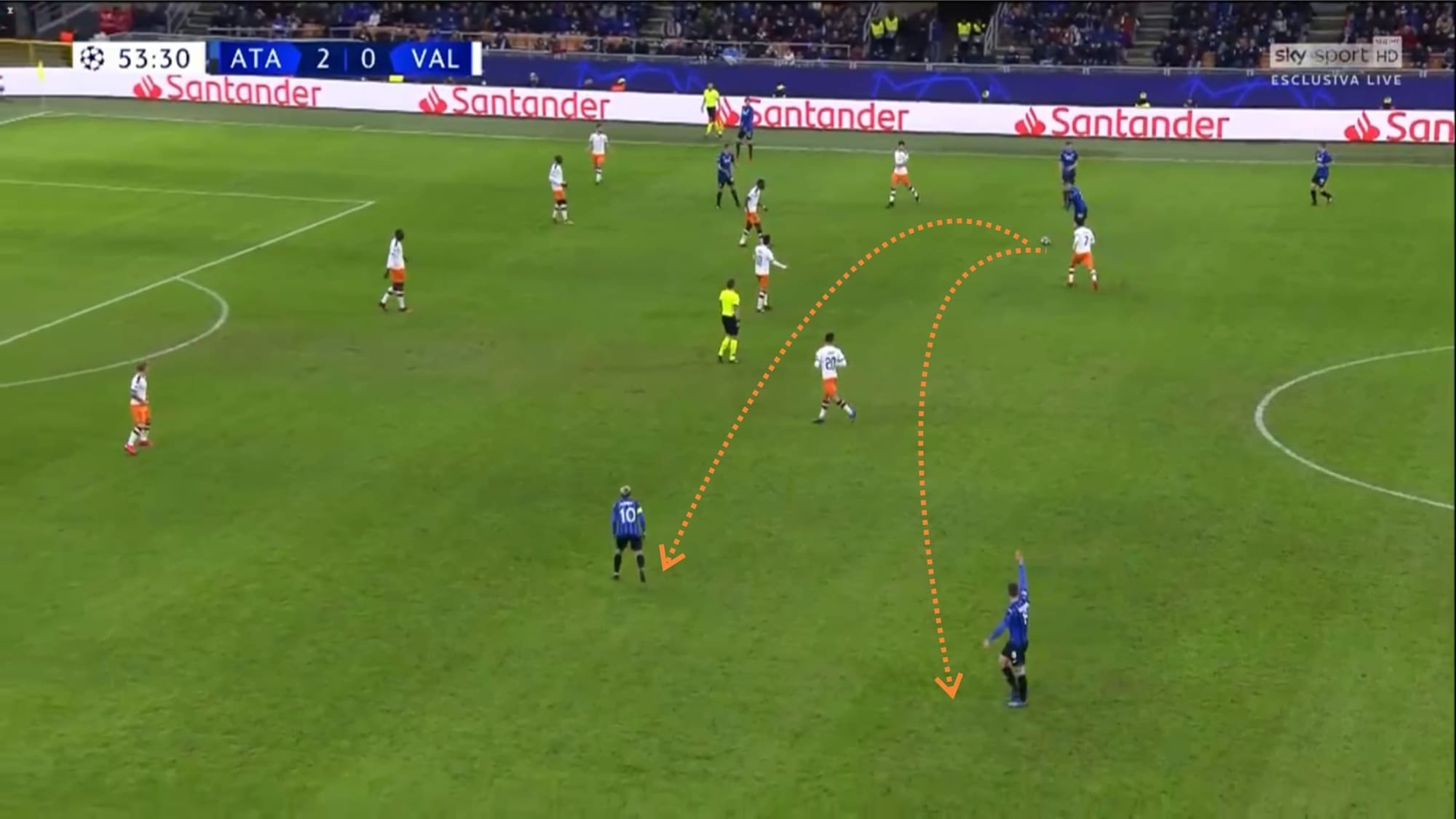
In the situation above, Atalanta created an overload on the right flank with their right-sided central midfielder sitting in the half-space, right-sided striker dropping and right-sided centre-back moving up. However, with passing lanes to advance deeper blocked, the ball-carrier decided to play the ball towards the left-sided striker on the left flank. From there, they could potentially create a 2v1 situation against Valencia’s right-back. However, the ball was successfully intercepted before it could reach the intended target.
You can also see above that interestingly, there’s no player that sat in central areas. As mentioned several times in this tactical analysis, Atalanta would attack and create chances from flanks by concentrating their players on one side and if the opportunity to break through the defence is unavailable, they’ll switch play. That doesn’t mean that they’re unable to break through centrally too. They definitely can, most of the time, via underlapping/inward runs from out wide.
With that said, there might be a solution that Valencia can use to anticipate Atalanta’s switch of play.
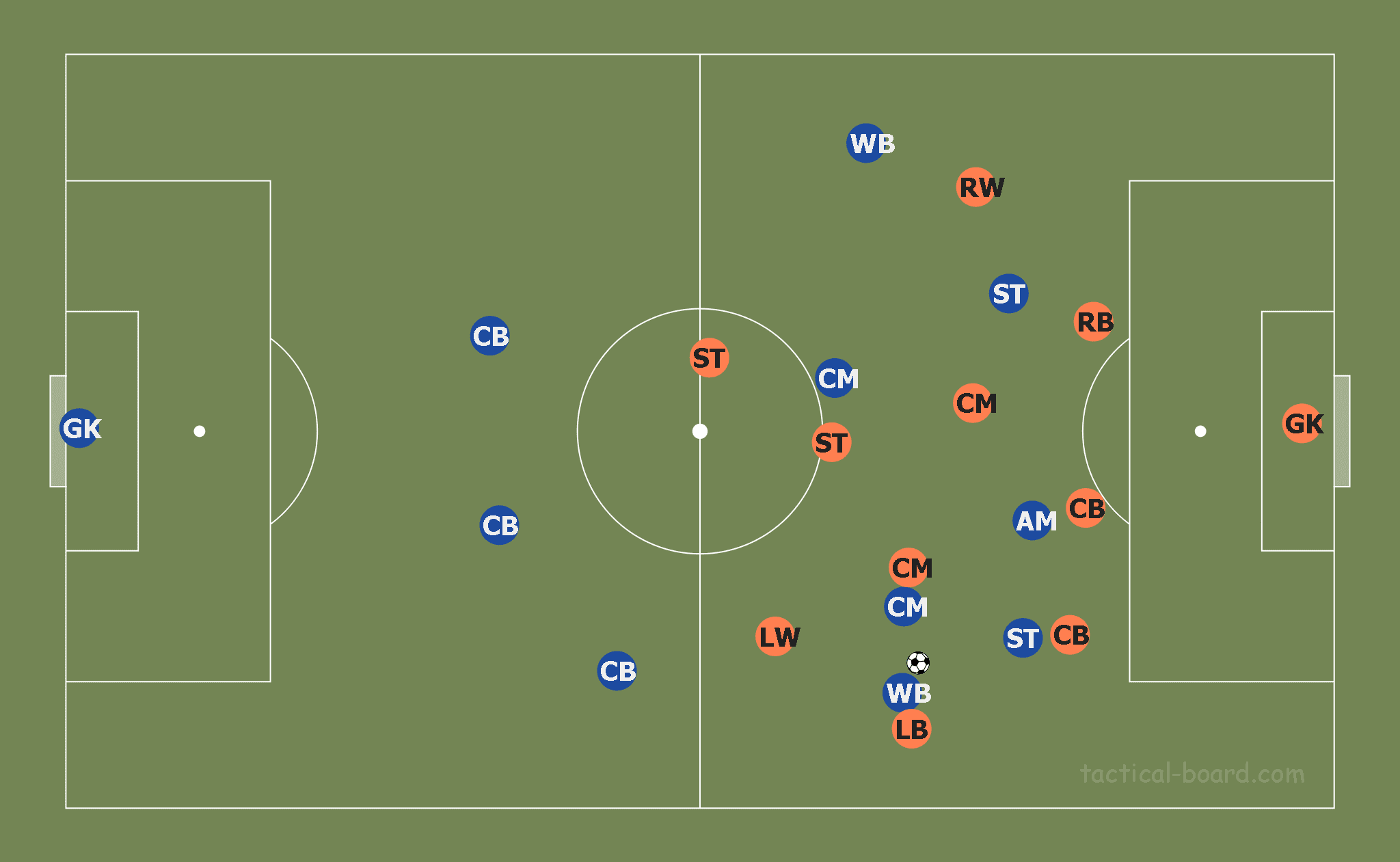
Earlier in this tactical analysis, it was mentioned that Valencia tended to defend with a narrow shape. If the ball is on one side, then the ball-far winger would maintain horizontal compactness by sitting close to the central midfielder. Narrow shape like this can prevent central progression. However, judging by their last meeting, Valencia clearly also need to defend the area on the opposite side.
Like in the picture above, instead of staying narrow, the ball-far winger should maintain width to defend the underloaded area. That way, they can defend the width better and ball-far full-back won’t receive too much trouble if Atalanta decide to switch play.
In order to seal the win, what Atalanta pretty much need to do is just to stay solid and defend well. They especially need to be careful of Valencia’s forwards’ explosiveness. Celades’ side are quite direct and very dangerous on the break. And with Atalanta’s tendency to commit men forward (including the centre-backs) to create overloads and maintain possession on the opposition half, they might just be quite vulnerable at the back. Quick and aggressive counterpressing could be an excellent solution to delay the counter-attack and potentially win the ball back.
For Gasperini’s side, perhaps opting for a cautious approach to deny Valencia the time and space to create openings and chances could be the best choice for this game.
Lineups and formations prediction

Both Celades and Gasperini are consistent in terms of formation. There’s little chance that there will be a drastic change of system in the next match but a little tactical tweak is possible.
Valencia (4-4-2)
Starting XI: Cillessen – Wass, Paulista, Diakhaby, Gayà – Torres, Parejo, Kondogbia, Cheryshev – Gameiro, Guedes
Atalanta (3-4-1-2)
Starting XI: Gollini – De Roon, Caldara, Palomino – Hateboer, Malinovskyi, Freuler, Gosens – Pasalic – Iličić, Gómez
Conclusion
Nothing is impossible and anything can happen in the 90 minutes of a football match. Valencia definitely still have a chance to redeem themselves, but Atalanta should be able to secure a ticket to the next round of UEFA Champions League if they’re playing the way they should be.
Although both teams look very much different with a different set of players, different tactics, system, and style of play – both teams actually seem to have similar weaknesses and issues that can be exploited with similar methods as explained in the tactical analysis above.
Both teams should already be aware of each other’s weaknesses and strengths by now and it will be extremely interesting to see what each manager will do to neutralise each other’s tactics.




Comments